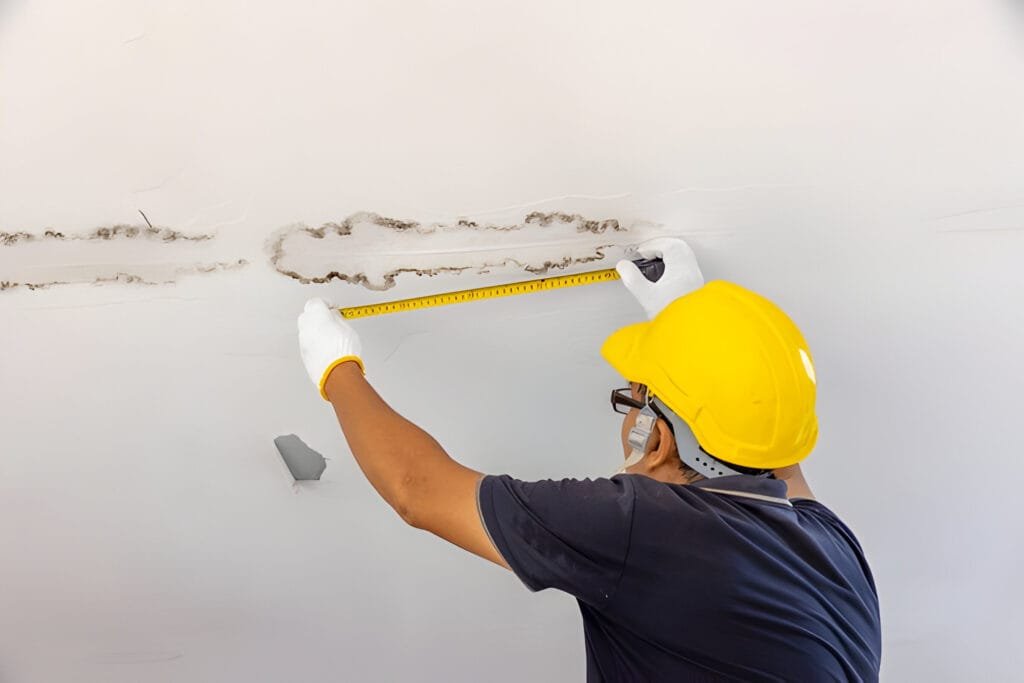If not repaired as soon as possible, the water that accumulates from a leaking roof in your home is likely to cause additional problems such as structural problems, fungus growth, and other serious problems that can prove to be expensive for you to resolve. To ensure your home is strong and does not have compromised roofs, you must know the cause of roof leaks and how to repair them. Let us have a look at the common causes of roof leaks:
Common Causes of Roof Leaks
1. Damaged or missing shingles
Shingles are on the outer layer of the roof and act as a shield against the harsh conditions outside. Shingles may wear out, get damaged by storms, or even crack, warp, or fall off due to changes in temperatures. If shingles are damaged or blown away, it becomes relatively easy for water to infiltrate your roof.
How to Fix It:
- Check the shingles for any damages or signs of missing ones frequently after experiencing storms.
- Fix damaged roofs immediately if you have missing or damaged shingles to avoid leakage. Make sure that the new shingles fitted are of similar size and material to the one used on the old shingles.
- If all has been severely damaged, consider calling a professional roofer to determine if you need full roof leak repair.
2. Clogged Gutters
Gutters are meant to carry water that falls on the roof to safe areas together with storm water. Water probably overflows and finds its way under the shingles in the process when they are chocked by dirt, leaves, and debris. This seems to be the trend mostly during the rainy season.
How to Fix It:
- Your gutter should always drain properly; clean it frequently. It may be preferable to do this at least twice annually, in spring and in the autumn.
- Buy and fix gutter guards because they help minimize the kind of debris that finds its way into the gutters.
- Check your downspouts so that they are well-directing water away from the foundation of your home to avoid a basement flood.
3. Cracked Flashing
Flashing is the metal used in sealing specific roof components like the chimneys, roof lights, or skylights, along with vents. Flashing can become damaged by age and the effects of the weather, and eventually it may rust or break, being one of the common leak sources.
How to Fix It:
- Check flashing for any cracks or signs of damage around the roof protrusions, such as vents.
- This can be done by using a sealant to cover small crack areas to avoid leakage for some time.
- If some of the flashing is severely compromised, then it must be replaced. This may require the stripping of shingles around the area and the installation of new flashing that is fixed with roofing cement to close any openings.
4. Improperly Sealed Roof Valleys
These are areas where two roof slopes meet, and if poorly designed, they can be areas that leak. Water always runs downhill to the valleys, and this is why any weaknesses, such as cracks, in this area can lead to severe water penetration.
How to Fix It:
- Check the roof valleys for any signs of wear and tear, bad repairs, or lapses.
- If you find such problems, then it is advisable to use roofing cement or a waterproof membrane to seal the valley again.
5. Ice Dams
This is especially true in cold areas where one finds ice build up along the edges of the roof, which normally prevents the dripping of melting snow. It therefore stagnates under the shingles, and with this, roof leak problems occur. This list is normally formed by inadequate insulation or ventilation of the attic, leading to the formation of ice dams.
How to Fix It:
- Seal up and insulate your attic to curb the formation of ice dams.
- Have to use a roof rake and remove the extra accumulation of snow on the roof after a snowstorm.
- Cover the whole roof surface with Ice and Water Shield membranes, especially along the roof edge, to enhance an extra layer of protection.
6. Loose or Missing Sealant at Roofs Emirates or Pointing
It involves the application of a material known as a sealant that is applied around these areas, including vents, chimneys, and skylights of a roof, and helps in preventing roof leaks. The sealant in the end wears, cracks, or peels off, which compromises the roof’s readiness for leakage.
How to Fix It:
- You have to have frequent checks on the sealant around your fixtures on the roof.
- In any subsequent redecoration, one has to apply new coats of sealants where there are signs of abrasion or other forms of deterioration.
7. Poor Installation
If your roof is not properly installed, then you might be prone to developing leaks. Defective shingles’ positioning, wrong placement of the flashing, or inadequate sealing help water into damaged structures.
How to Fix It:
- If you have poor installation work thinking that your roof was not well done, consider hiring a professional roofer to inspect the roof. Professionals can identify the extent of the problem and advise whether it can be solved by local repair or if a complete roof renovation is needed.
8. Skylight Leaks
Everyone loves updated windows in a house, but unfortunately, if not well fitted or perhaps in case they have been damaged, they lead to leaks. Water seepage can be a result of a space between the skylight and the roof or could be a result of damaged flashings.
How to Fix It:
- Check the condition of the seal around the skylight; if the seal appears to be broken or worn, you should replace it.
- To perform the final assessment of all the problematic areas in the skylight, check whether the glass has developed any cracks, and in case of any, change the glass.
- Check that the flashing around the skylight is well-fixed and in perfect condition. If you need a new one, then you may have to replace the flashing because this type of material may no longer be efficient.










